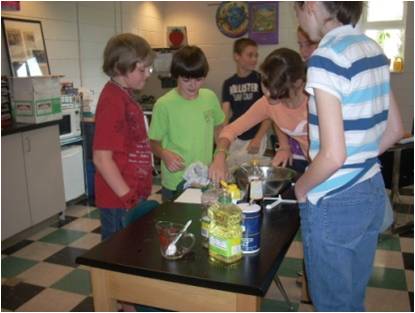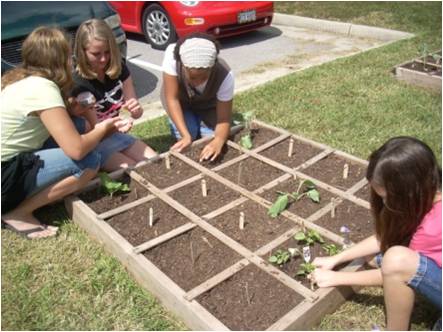 After a few months of growing vegetables at Glenvar Middle School in Salem, Va., the students’ favorite recipes are “Hot Chinese Cabbage,” “Raddish Top Soup,” and “Mustard Greens Fried Rice.”
After a few months of growing vegetables at Glenvar Middle School in Salem, Va., the students’ favorite recipes are “Hot Chinese Cabbage,” “Raddish Top Soup,” and “Mustard Greens Fried Rice.”
Not only did they learn how to grow the food, they learned how to cook it as well! By the middle of the school year, the sixth grade students had accumulated enough recipes to create their own cookbook for their parents as a gift.
With the help of a GreenWorks! grant from Project Learning Tree, the project started as a method of engaging a class of 16 high-risk students in sixth grade. Over the years, it has grown to include more than 140 sixth graders.
First, students built four raised-bed gardens. The students then researched recipes and voted on their favorites.
During the fall, we cooked almost every Friday in the classroom using an electric skillet.
These students are not only excited about growing vegetables – they are eating healthy!
I used the National Gardening Association’s guide “Health and Nutrition from the Garden” to give me more ideas to help my students implement healthy life-style changes. As the students began to appreciate the food they were growing and eating, they were ready to expand the gardening experience into their own homes.
Students selected plants for their home gardens, and in February we planted seeds for seedlings to go home with each student. The first year the students grew over 300 seedlings to transplanting size.
The Glenvar gardens were planted with salad vegetables, and the students learned not only how to grow and take care of them, but they also practiced scientific investigation. When school came to an end, at least two plants went home with each student and we harvested enough salad greens to feed every sixth grader all the salad they could eat during the exam period break. The students left school confident in their ability to grow and cook their own food.
 Expanding and building a greenhouse
Expanding and building a greenhouse
Before the year was out, the wall-to-wall seedlings in every window and under every light in my classroom highlighted the need for expansion. In partnership with one of our eighth grade math classes, students began to make plans for a greenhouse!
I’m proud to say that a high-hoop style greenhouse has recently been built by the eighth grade “Green Math” class behind our school. The math students have also spent countless hours building and installing two cold frames on our existing raised beds, as well as constructing eight additional raised beds for the new greenhouse.
In April, the spring seedlings of tomatoes, peppers, and eggplants are starting to pop up all over my room. Carrots and beets are also growing under our cold frames, and the lettuce and spinach planted in our outdoor gardens has recently been refreshed with compost. I’m thrilled that Project Produce has expanded into multiple disciplines and grade levels and is touching countless students and families at Glenvar Middle School.
Tips for engaging your students in gardening projects
Involve students early on
Involve students in decision-making even before a project’s inception, and help them incorporate their interests into a research plan. For example, Project Produce students at Glenvar Middle School were responsible for researching which plants would grow best in their local area.
Use planning as a learning opportunity
Get students to ask—and answer—complex questions during the project planning. For example, Glenvar students needed to know What is the volume of soil needed to fill a 4′ by 4′ raised garden bed?
Project Produce students are responsible for all aspects of garden growth, including transplanting, watering, weeding, monitoring, and protecting the plants during unseasonable weather.
Assign specific projects to groups
I assigned groups of Glenvar students into “gardening families” and each group designed and implemented a garden layout. Collectively, these young gardeners planned which vegetables each group should plant in each assigned garden plot.
Establishing these groups created a sense of accountability among the students. Through their collaborative approach, students understand that they depend on each other. For example. if a plant is not growing or there is evidence of pests, students must make inferences to determine the cause of the problem.
Reach out to community partners
External supporters can become your champions, and help your students research, plan, and continue project maintenance. Through effective outreach, your project can receive financial support, media attention, and extra helping hands.
Our students partnered with Virginia Cooperative Extension Agent Sheri Dorn to plan and build the original raised-bed gardens. David Williams, a master gardener, continued the partnership with the students as they built “critter cages” to keep out unwanted 4-legged visitors.
Mr. Williams also helped the students set up a red wiggler worm bin in which students place their lunch scraps to make rich compost for the garden. He visited the classroom frequently and acted as a mentor both within the school program and also in the students’ homes and in our community.
Project Produce has been the subject of several newspaper articles, and I have presented it at several state education conferences. Katie Williams, former Glenvar Middle School teacher, volunteered her time to help write—and secure—the GreenWorks! grant. Our local Parent Teacher Association and the Roanoke County Schools Education Foundation provides support to Project Produce, and Koppers Industries committed financial and in-kind support when extra materials or labor were needed for the garden.
Celebrate and share
A school garden is only one idea for an educational and rewarding environmental service-learning project. Successful projects involve your local community and require students to think creatively. They also include different subjects, age groups, or abilities.
Glenvar Middle School students are the harvesters—literally—of their project’s successes. For their first spring harvest, students collected 25 gallons of spring greens from their gardens and donated over 20 gallons to the local Rescue Mission. A few years later, they harvested two gallons of red Russian kale, dwarf blue kale, India mustard, and southern giant mustard. From this, students made—and blogged about—garden cornbread. The final harvest from last fall’s garden was in early January, and students created dishes in the classroom with four cabbages, harvested frozen!
Check out the Project Produce blog to learn more.


